I am continuing to re- and re-read Schmid’s chapter on edges, because I’m not sure I have a decently full grasp of what he’s saying.
The book is Alla Prima: Everything I Know About Painting by Richard Schmid ($50 USD in soft cover from him; more from Amazon and more in hard cover).
Schmid begins his chapter by saying “Think about edges the way you would think about kissing someone…. Think of edges as exquisite subtleties, as the means to transmit romance, as ways to make your dabs or paint whisper or shout and reach nuances beyond the range of color. Think of them as visual poetry… but especially think of edges as you would the agents of expression in music….pianissimo (very soft), andante (flowing), allegro vivace (fast and lively), maestoso (majestic), fortissimo con sforzando (whamo!).
He’s speaking of edges that create an illusion (emphasis is Schmid’s) of how we ordinarily see, and some of what he says is quite common knowledge — that atmosphere, particularly at a distance, softens and cools elements, and hence edges. And so forth.
But the two aids to seeing edges, he says, are “Squinting and Comparison — [the same] that I [Schmid] described in the … chapter on values. They are essential in working with edges and you must do them together.
So today I was out painting Alla Prima (or plein air, if you are a francophile, or in the rain if you are a realist), and I forgot entirely about edges. But the conditions were just right for comparisons. I thought I’d swing through today’s efforts (remember, I’m a studio fixer-upper of paintings, so these are wet drafts) and think about edges and comparisons — and if that isn’t enough, go on to look at one of Schmid’s examples.
It being October 31, the rains have started, and it was pouring when we left the house. We went down to the river, where Interstate 5 runs along and above it. We sat beneath the interstate to stay out of the rain. Each of these paintings were about an hour’s worth of work: the one above is Hawthorne Bridge, Rainy Day, 12 x 16″, oil on board.
Later that day, in honor of the Trick-or-Treaters, the sun came out.
I moved my easel out into the sun where it was warmer and brighter, and painted for another hour. This isn’t exactly the same scene (duh!) but it’s the same bridge and river and some of the same buildings.
Hawthorne Bridge after Rain, 12 x 16, oil on board
Obviously the rainy one features cool blues; the colors warm up considerably when the sun came out (as did the painter). But the edges changed too. In the earlier painting, the mist in the air blanked out the west hills, behind the city. I smudged them in at the last moment, but they are still without much interest. When the sun came out, the hills were still wet and a bit misty, but the fall colors were oozing through and the hills in the painting become far more alive.
The edges of the hills in the rain painting are faked; the form is just stuck there (I hadn’t had lunch yet). But in the second painting, the edges and the sky intertwine and it’s hard to tell where one starts and the other ends — which was as it was. Here are a couple of close-cropped details of each:
On th other hand, I think I got the edges of the bridge in the rain more “authentically” than the one in the sun, where again, it was at the end of the session. I needed to make sure the bridge was there, so I slashed a line of paint that doesn’t catch the sun on the edges — I think a change of hue as well as value is required.
This is but a beginning in this venture of edges. I did think about the buildings and how their edges should be painted, but I haven’t sussed out yet quite the degree of sharpness in varying conditions and so I tend to just throw up a line that tells us all that that’s a building edge. But I’m aware of the challenge, so maybe I’ll get to the process in due time.
I will attempt to get at these edges before the paint dries — Schmid warns about the difficulties of mooshing edges after the oil is dry to the touch — but looking at the raw version is illuminating.
Here’s a Richard Schmid — not the one from the book, but something similar:
Schmid’s oils often resemble watercolors — not my style. But his ability to analyze the whys and wherefores of certain processes, and his sense of humor, are well worth feeling a bit inadequate in the face of his work.
And how are your edges doing these days? By the way, I started this post thinking about squinting and comparisons, but the comparisons I made here aren’t what Schmid is speaking of — he means comparing the values and edges at the real site, squinting to make out what the strongest ones are and where they disappear. He also warns against squinting at the canvas. He even has a whole page on the practice of squinting. “Lastly” he says, “it only works marginally when working with photographs. SQuinting at a photo is about the same as squinting at a painting. Everything gets fuzzy. Squinting for values in a photo is sometimes useful, but because of the limited data caught by the camera, the information you can obtain is minimal compared to squinting at the real thing.”
I wanted to show him Steve’s photos!
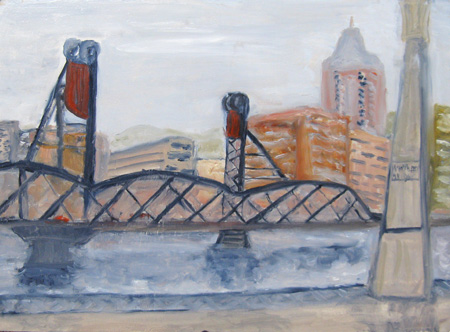
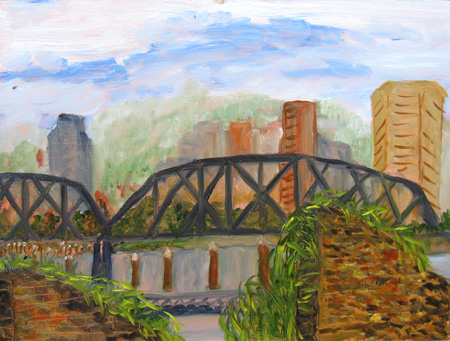
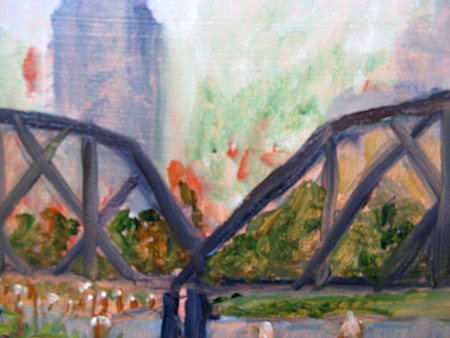
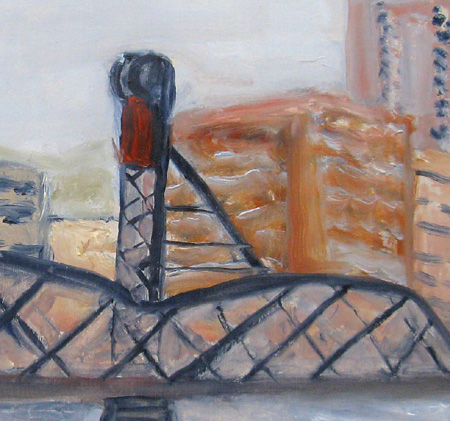
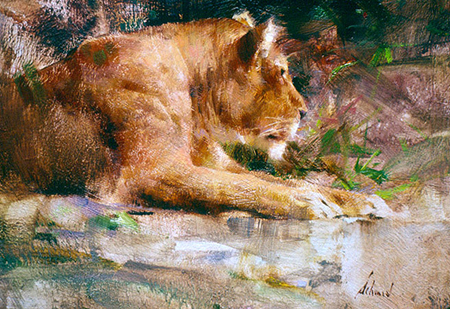

June:
I’ll squint at my breakfast cereal so it’s not always clear when the artistic squinting kicks in.
A consequence of my amblyopia – otherwise known cas “lazy eye” – is the development of two different ways of looking, left and right. This meant that I saw two ministers during church – one rather out of focus and wandering vaguely about. This means too that each eye tells its own tale. I will squint to help pull the bad eye into focus, and it will then give me its own take on color, line and form relationships. Only works after I have removed my glasses.
This whole idea of the essential role of edges is one I’m finding very productive. I expect I’ll be chewing on it for a long time. It reminds me of the notion that the skill of a musician is not in hitting each note correctly, but in how she gets from one to the next. Sounds like edges to me.
I don’t understand the value of squinting for edges. I always thought that squinting a) reduces the field of view, isolating the subject, and b) defocuses the eye, so one sees not the details but the broad patches of color/value, helping to assess the composition. I don’t normally squint myself, but I often close one eye to get a non-stereo, camera-like view.
Here in dry Montana, edges tend to be pretty hard if you focus on them. Which makes rain or snow or mist all the more interesting.
Steve,
My book is by my bedside and I’m too lazy to go get it, but my memory of what Schmid says is that squinting clarifies values — darks and lights — but is absolutely the wrong thing to do for color — it darkens everything. With the simplification of value, you can see where edges are lost and where they are sharp. His theory is that as we paint (or photograph, for that matter) we tend to open our eyes wider to see better, which works for color, but doesn’t work for the complexity of edges — that is, we’ll tend to make them harder than they would look to the ordinary observer.
But always he’s talking about the simulation of reality, not abstraction — and probably not even faux representations (or wonky paintings) like my own. Still, I find his analyses give me choices that I can then work with.
One other tidbit I read about color last night (this will be of interest only to those who paint) is that shadows are always the opposite in temperature of the light — so a sunlit evening scene will have cool shadows. And, he says, keeping a consistent temperature (toward yellow/toward blue) across the canvas will unify and harmonize the colors.
I just tried fixing a canvas that I liked a lot but found lacking, and by golly, I think he’s right, both about shadows and about unification. Of course, this is probably stuff most painters knew from their mother’s knee, but I never had it put so simply and clearly.
Oh, and indeed the edges of things in Montana do tend to be pretty hard, even in December. It’s all that light! Now in Oregon…….
And Jay, just make sure you know where the edge of the coffee cup is when you are breakfast squinting.
Tonight, I will order Schmid’s book even though his lion looks like a pussy cat on ice.
I finally learned why I don’t like photographing in evening light – the light of the shadow is cool.
I often close one eye to get a non-stereo, camera-like view. I wonder why Karl, as a painter, used to do that a lot.
I think closing one eye is even more helpful for painters than for photographers. Not only can composition be seen more clearly, but also the relationships of lines and shapes that painters have to draw for themselves. Many also hold a pencil or brush horizontally or vertically, which pretty much requires viewing with one eye to be most useful.
the pencil holding is actually taking a measurement so that you can get a fix on the relative scale of the objects.
June:
An edge is an edge, is an edge I allege
Can be sharp as a sword
Or as soft in the air
As a whiff of Arpege
It’s what separates
The this from the that
Other Seussian stuff
From the Cat In The Hat
Jay —
What would Seuss say about 6 degrees of separation (I mean, the this from the that!)
Steve,
Melanie is correct that pencil holding is measuring — often angles as well as relative scale. But you are correct that it’s hard to do with both eyes open — makes me feel a bit cross-eyed when I try.
Birgit —
I’m not terribly fond of Schmid’s paintings, myself, although they are definitely accomplished. He paints pleine air like a watercolorist. His portraits are more interesting than that tiger, for sure.
But I think you’ll find that, even where you disagree with his ideas about painting, he gives you a nice start to push against. And he really is good at sorting out the myths from the realities. I’m actually going through the book, taking notes, not because the notes will ever be looked at again, but because writing things down often fixes them in my wee brain. Going back over the material, too, makes me see more in what he has written. So enjoy the book, even if the tiger gives you the willies. Or frostbite….
June:
He’d have said something edgy. Thanks for the setup.
The tiger has about it an air of taxidermy. Schmid makes me think abstract specificity, in the sense that his stuff seems to have nothing much to say, but he is wonderfully eloquent in his recitation. This is not a complaint as I have a warm regard for those who can present the familiar so well.
you people that criticize schmidts paintings, i can only imagine what kinda joke your paintings are!!
i m the big fan of richard schmid and i lve all his landscapes and seascape
Rereading this post and its comments is helping with my current painting – especially Steve’s comment: